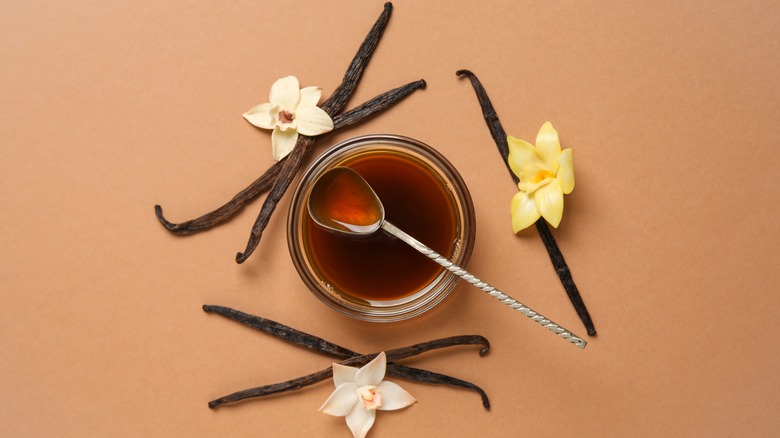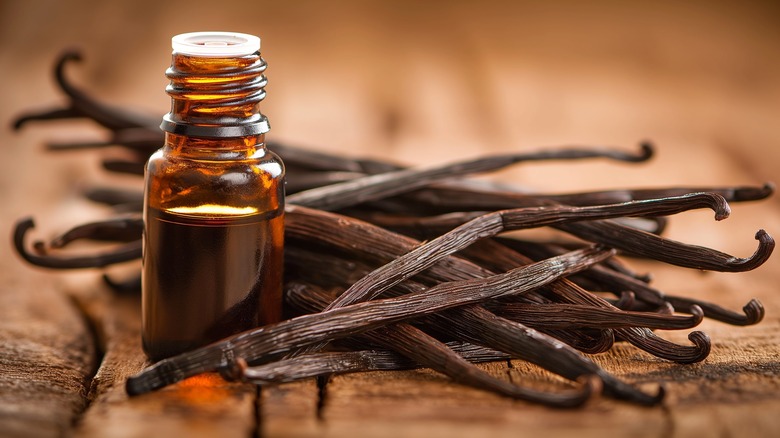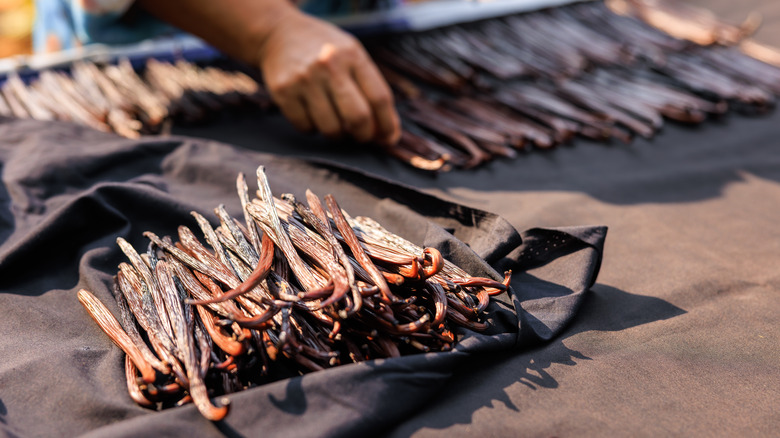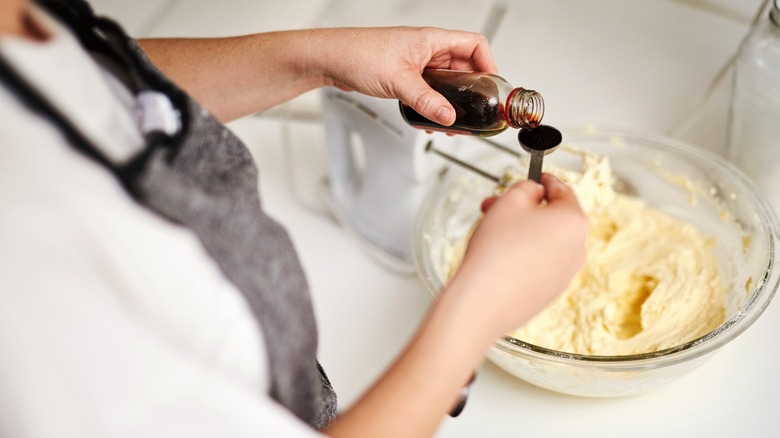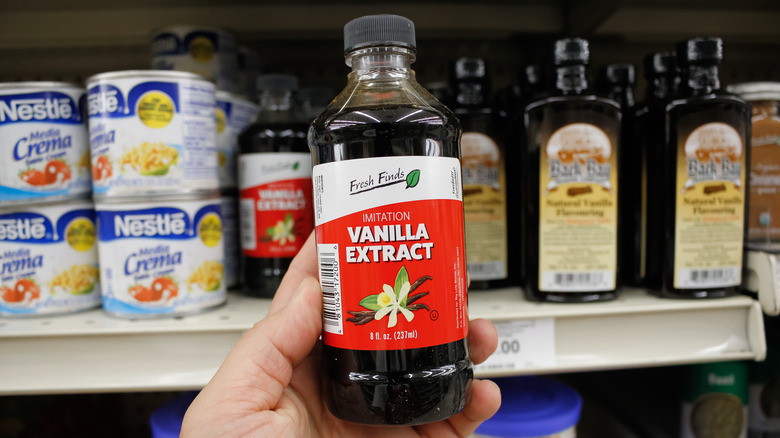Single Vs Double Fold Vanilla Extract: What's The Difference?
Vanilla extract is one of the most popular spices in the world thanks to its velvety sweetness and warm flavor profile. But even something as simple and delicious as vanilla ice cream can get pretty complicated once you look under the hood. For example, if you're aiming to be more conscientious about your vanilla use, it's good to keep in mind that there are different types of vanilla plants that produce specific types of vanilla beans, each with their own unique flavor. Another aspect worth paying attention to is the fold of the vanilla extract. To put it simply, the fold of vanilla extract refers to how concentrated the extract is.
Not everyone is happy about vanilla extract's popularity thanks to its high prices, outsized impact on the environment, and the nearly ubiquitous use of imitation vanilla extracts. But even if there are plenty of vanilla extract substitutes that taste like the real thing, there's still something undeniably delicious about using pure vanilla. In any case, the use of vanilla extract isn't going away any time soon, and familiarizing yourself with the different forms it takes can only help you be a better chef.
What is single-fold vanilla extract?
Single-fold vanilla extract is, essentially, the baseline. Every pure vanilla extract you buy from the store will be single-fold unless they specify otherwise on the label that it's double-fold or even triple fold. Vanilla extract products are required by the FDA to have a concentration of at least 13.35 ounces of vanilla beans for every gallon of alcohol, which means 13.35 ounces of vanilla beans is considered single-fold.
Remember that fold is a measure of concentration, and concentration is relative, so if you add or subtract other ingredients from the extract, you would need to adjust the amount of vanilla beans to keep the ratio the same. Most of us aren't buying a gallon of vanilla extract, so the number of ounces of vanilla beans contained in your 4-ounce bottle of vanilla extract will be quite a bit less than 13.35.
Vanilla extract typically only contains vanilla beans, water, and ethyl alcohol, so the ratio isn't all that complicated to adjust. This is all done during the manufacturing process, so unless you're making vanilla extract yourself at home, there's little more you need to understand other than that single-fold is the baseline.
What is double-fold vanilla extract?
Double-fold vanilla extract is exactly double the concentration of single-fold vanilla extract. So if single-fold vanilla extract is 13.35 ounces of vanilla beans, that means double-fold vanilla extract contains 26.7 ounces of vanilla beans per gallon of alcohol. As you might imagine, the extra vanilla used translates into a higher price point for an already expensive cooking spice, but if money is no object, then you'll be treated with a vanilla extract that is sweeter and more flavorful than the single-fold version.
If all this talk of concentration still has you somewhat confused, it may help to know more about how vanilla extract is made. The hardest part about making vanilla is growing the beans — that's where the high cost comes from. Once the beans are ready, the process is actually quite simple. The vanilla beans are soaked in what is essentially vodka and then strained out. What you have left from the process amounts to an alcohol infusion, or tincture, where the alcohol acts as a solvent that the flavor compounds from the vanilla beans are pulled into.
Keep in mind that ounces-per-gallon refers to the amount of vanilla beans themselves, not the concentration of the flavor compounds that have been extracted. So if there are, say, five beans in single-fold, that means there are ten beans in double-fold. It doesn't take into consideration how long the beans are infused for.
Double-fold vanilla extract provides double the flavor
You may be thinking to yourself that if you buy the double-fold vanilla extract, you can halve the amount of vanilla you normally use in a recipe, effectively saving you some money. It's a pretty budget savvy idea, and we aren't going to stop you, but it's sort of frowned upon in the culinary world. It probably has to do with why the fold system exists at all — which is to say, vanilla extract manufacturers aren't producing products with a higher concentration because single-fold vanilla extract takes up too much space or because it would be better if less extract was required in a particular recipe. Double-fold extract is made specifically to boost flavor, and that benefit goes away the minute you effectively dilute it back down to single-fold.
There's also a chance that reducing the physical volume of vanilla extract that you put into a recipe negatively impacts the dish in other ways that make it so that 1 teaspoon of single-fold vanilla extract does not equal ½ teaspoon of double-fold vanilla extract, though we haven't tested it to find out. Whatever the reason, halving the double-fold vanilla extract is, unfortunately, bad cooking practice. Both types of vanilla extract have the same shelf life, though.
How does imitation vanilla extract play into this?
Primarily because pure vanilla extract is so unbelievably expensive, imitation vanilla extract has become a highly popular substitute. Unlike pure vanilla extract, imitation vanilla extract is made synthetically by extracting vanillin from something other than vanilla beans. Vanillin is the flavor compound responsible for vanilla's iconic taste. When the vanilla beans are soaked in alcohol, it's the vanillin that is escaping from the bean and imparting its flavor to the extract (among several other flavor compounds).
But as you may remember, the fold of vanilla extract refers to the amount of vanilla beans, not the amount of vanillin. Because imitation vanilla extract uses zero vanilla beans, the designation of single or double-fold no longer applies. Imitation vanilla extract can be made from all kinds of products, from wastewood to petroleum to plant fibers. At one point, vanilla extract even contained beaver butt juice, though it's highly unlikely that you'll find that ingredient (known as castoreum) in vanilla extract today.
It's worth mentioning that imitation vanilla extract often has a much higher concentration of vanillin in it than pure vanilla extract, though the other flavor compounds from vanilla beans are obviously lost. Because the imitation products source the vanillin much cheaper, increasing the concentration of vanillin is easy and profitable. So if you're trying to maximize the vanilla flavor, aren't afraid of synthetic food products, and are operating on a budget, imitation vanilla extract could be a better option than double-fold vanilla extract.
